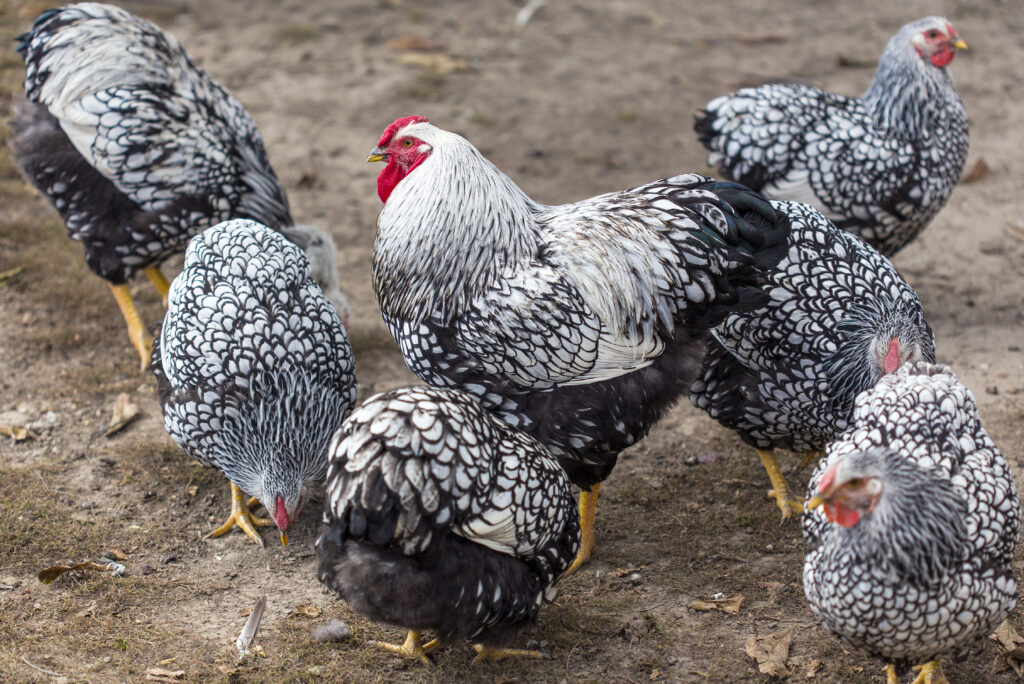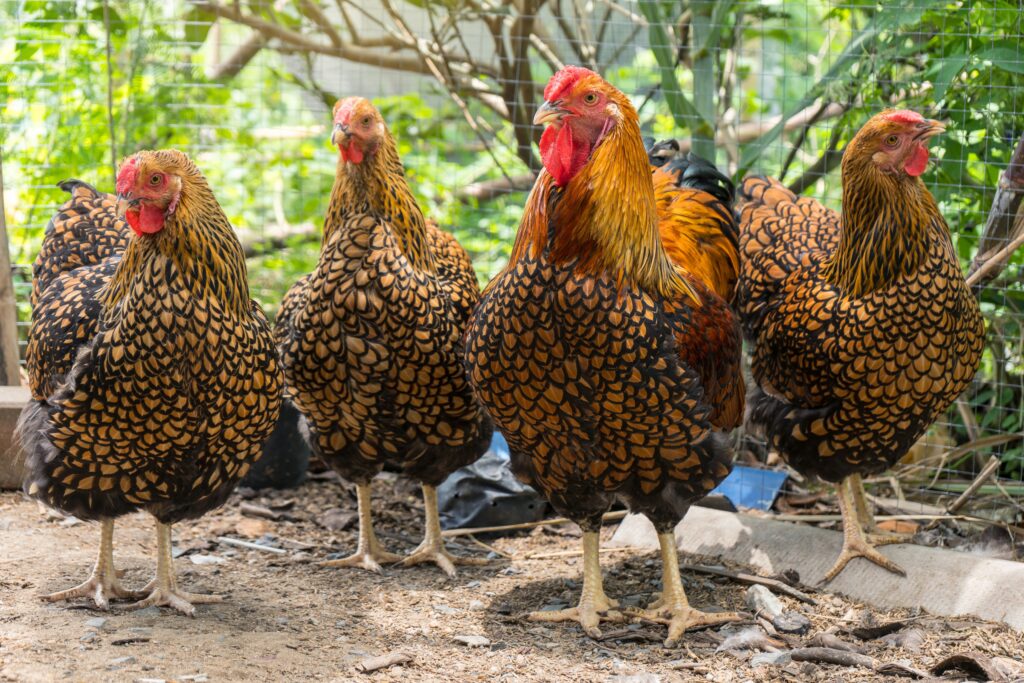The Wyandotte chicken was the first dual-purpose chicken bred in America. These chickens were developed in the United States in the 1870s. Breeders desired to create a chicken that could produce both large quantities of eggs and ample amounts of meat. The fact that Wyandotte chickens grew rapidly and were resistant to frostbite made them especially valuable birds. Their price soared during the latter part of the 19th century, but their popularity declined as commercial breeds took over. Conservationists have worked over the last several decades to bring back the Wyandotte chicken. In 2016, the breed graduated from the Livestock Conservancy’s Conservation Priority List, as its numbers rebounded to sustainable levels. Today, Wyandotte chickens are popular once again in backyard flocks, thanks in large part to their egg and meat production and their attractive plumage. Let’s take a moment to compare the Wyandotte hen vs. rooster and explore some of their important differences.

Distinguishing the Wyandotte hen vs. rooster can be challenging because they have similar plumage.
©Don Pablo/Shutterstock.com
Wyandotte Hen vs. Rooster: Size
Wyandotte chickens have medium to large-sized, curvy bodies. They exhibit significant sexual dimorphism with regard to size. Standard-size hens weigh roughly 25 percent less than roosters. Wyandotte roosters reach weights of about 8.5 pounds, while hens weigh an average of 6.5 pounds. Bantam-size hens and roosters average approximately 2.5 pounds.
Wyandotte Hen vs. Rooster: Plumage
When they are young, Wyandotte hens and roosters can be difficult to distinguish from one another. Whether laced or solid colored, the hens and roosters have similar plumage until they begin to approach maturity. Both sexes have close feathers that appear silky and not overly fluffy. Laced varieties have feathers of a light color, usually either silvery white or golden, rimmed with crisp, black edges. As roosters get older, they grow longer, pointed hackles and saddle feathers. They also grow longer tail feathers than hens.
The silver-laced variety of the Wyandotte chicken was the first to be admitted to the American Poultry Association’s Standard of Perfection in 1883. The APA recognized the golden-laced variety in 1888. Today, the APA recognizes 19 different varieties of Wyandotte chickens, including 10 bantam types.
Wyandotte Hen vs. Rooster: Other Physical Characteristics

Wyandotte roosters have slightly larger combs and wattles than hens.
©Ton Bangkeaw/Shutterstock.com
Although Wyandotte hens and roosters have similar looks overall, they do differ in a couple of their other physical characteristics. Wyandotte roosters have bright red, flattened rose combs that fit closely to their heads. They also have relatively short red wattles, red earlobes, and red faces. Wyandotte hens also have red, rose combs, but theirs are smaller. Their red wattles are smaller than those of roosters, too. They also have red earlobes and faces.
Wyandotte chickens have strong, yellow legs and feet with four toes. Their strong beaks are a dark golden color. Both sexes also have distinctly orange eyes.
Wyandotte Hen vs. Rooster: Temperament
Wyandotte chickens are generally friendly, calm, and docile. They tolerate handling well, and they make good show birds. They have a slow, easy-going nature that makes them an enjoyable backyard companion. Owners describe Wyandotte chickens as talkative, but not excessively noisy.
This breed enjoys free-ranging, but they also tolerate confinement easily. They are not great flyers, but they can reach high roosts and can easily get over low fences. Owners should plan to invest in a tall fence or a covered enclosure to keep these chickens secure.
Wyandotte chickens do not tend to behave aggressively toward humans. However, they do not typically enjoy being cuddled. They get along well enough with most other chickens in a mixed backyard flock. Both hens and roosters tend to be dominant and somewhat pushy toward other breeds. Owners often describe Wyandotte chickens as aloof. They tolerate other breeds but prefer to stick to their own kind in mixed flocks.
Wyandotte Hen vs. Rooster: Egg and Meat Production
Wyandotte chickens have always been bred for both meat and egg production. Well known as productive layers, Wyandotte hens lay roughly 200 eggs per year. They lay consistently, even throughout the winter months. These chickens begin laying eggs between the age of 16 and 20 weeks, much earlier than some breeds, such as the Brahma chicken. During their peak production years, Wyandotte hens can produce an average of four large, brown eggs per week. They do tend to go broody, and breeders say they make very good mothers. Wyandotte chickens usually have around 12 chicks in each brood. Their egg production begins to wane after they reach about three years of age.
Wyandotte chickens also make excellent meat birds. The roosters grow very quickly to full size, reaching up to 8.5 pounds. They provide ample amounts of lean meat at about five to six months of age. However, for the most tender meat, breeders recommend harvesting by about four months.
Wyandotte Hens vs. Roosters: A Summary
Here is a summary of the differences between Wyandotte hens and roosters. This breed displays considerable sexual dimorphism in size, but very similar plumage, especially prior to reaching maturity. Wyandotte hens and roosters are relatively easy to distinguish from one another once the individuals reach about 16 to 20 weeks of age. That is when hens start laying eggs and roosters begin to crow.
| Hens | Roosters | |
|---|---|---|
| Size | Up to 6.5 pounds | Up to 8.5 pounds |
| Plumage | Close feathered, not too fluffy; laced varieties have light feathers rimmed in black; short, upright tail | Same as female, but with longer hackle and saddle feathers and longer tail feathers |
| Other Traits | Bright red, rose comb, red wattles, earlobes, and face; yellow, bare legs and feet | Bright red, rose comb, red wattles, earlobes, and face; yellow, bare legs and feet |
| Temperament | Friendly and calm; dominant toward other breeds; tendency to go broody | Friendly and calm toward humans; dominant or pushy toward other breeds |
| Production | Large brown eggs; about 200 per year; consistent year-round production | Best quality meat before 4 months of age; meat after 8 months is tough |
The photo featured at the top of this post is © Don Pablo/Shutterstock.com
Thank you for reading! Have some feedback for us? Contact the AZ Animals editorial team.







